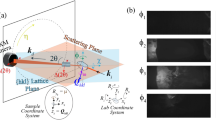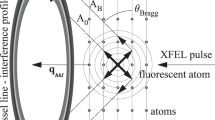Abstract
Knowledge of atomic diffusion is a fundamental issue in synthesis and stability of materials. Direct studies of the elementary diffusion event, that is, how the individual atoms ‘jump’, are scarce, as the available techniques are limited to selected systems1. Here we show how by monitoring the spatial and temporal variations of the scattered coherent X-ray intensity the diffusion of single atoms can be studied. This is demonstrated for the intermetallic alloy Cu90Au10. By measuring along several directions in reciprocal space, we can elucidate the dynamical behaviour of single atoms as a function of their neighbourhood. This method, usually referred to as X-ray photon correlation spectroscopy2,3,4,5 (XPCS), does not rely on specific atomic species or isotopes and can thus be applied to almost any system. Thus, given the advent of the next-generation X-ray sources, XPCS has the potential to become the main method for quantitatively understanding diffusion on the atomic scale.
This is a preview of subscription content, access via your institution
Access options
Subscribe to this journal
Receive 12 print issues and online access
$259.00 per year
only $21.58 per issue
Buy this article
- Purchase on Springer Link
- Instant access to full article PDF
Prices may be subject to local taxes which are calculated during checkout


 plane in reciprocal space.
plane in reciprocal space.

Similar content being viewed by others
References
Vogl, G. & Sepiol, B. in Diffusion in Condensed Matter (eds Heitjans, P. & Kärger, J.) 65–92 (Springer, 2005).
Sutton, M. et al. Observation of speckle by diffraction with coherent X-rays. Nature 352, 608–610 (1991).
Brauer, S. et al. X-ray intensity fluctuation spectroscopy observation of critical dynamics in Fe3Al. Phys. Rev. Lett. 74, 2010–2013 (1995).
Dierker, S., Pindak, R., Fleming, R., Robinson, I. & Berman, L. X-ray photon correlation spectroscopy study of Brownian motion of gold colloids in glycerol. Phys. Rev. Lett. 75, 449–452 (1995).
Shpyrko, O. G. et al. Direct measurement of antiferromagnetic domain fluctuations. Nature 447, 68–71 (2007).
Mehrer, H. Diffusion in Solids: Fundamentals, Methods, Materials, Diffusion-Controlled Processes (Springer, 2007).
Springer, T. & Lechner, R. E. in Diffusion in Condensed Matter (eds Heitjans, P. & Kärger, J.) 93–164 (Springer, 2005).
Schönfeld, B., Portmann, M. J., Yu, S. Y. & Kostorz, G. The type of order in Cu-10 at.% Au—evidence from the diffuse scattering of X-rays. Acta Mater. 47, 1413–1416 (1999).
van Hove, L. Correlations in space and time and Born approximation scattering in systems of interacting particles. Phys. Rev. 95, 249–262 (1954).
Sutton, M. in Neutron and X-ray Spectroscopy (eds Hippert, F., Geissler, E., Hodeau, J., Lelièvre-Berna, E. & Regnard, J.) 297–318 (Springer, 2006).
Chudley, C. T. & Elliott, R. J. Neutron scattering from a liquid on a jump diffusion model. Proc. Phys. Soc. 77, 353–361 (1961).
Fujikawa, S., Werner, M., Mehrer, H. & Seeger, A. Mater. Sci. Forum 15, 431–436 (1986).
de Gennes, P. G. Liquid dynamics and inelastic scattering of neutrons. Physica 25, 825–839 (1959).
Dasannacharya, B. A. & Rao, K. R. Neutron scattering from liquid argon. Phys. Rev. 137, A417–A427 (1965).
Caronna, C., Chushkin, Y., Madsen, A. & Cupane, A. Dynamics of nanoparticles in a supercooled liquid. Phys. Rev. Lett. 100, 055702 (2008).
Sinha, S. K. & Ross, D. K. Self-consistent density response function method for dynamics of light interstitials in crystals. Physica B 149, 51–56 (1988).
Wolf, D. Theory of Mössbauer line broadening due to correlated diffusion in crystals. Appl. Phys. Lett. 30, 617–619 (1977).
Sholl, C. A. Diffusion correlation factors and atomic displacements for the vacancy mechanism. J. Phys. C 14, 2723–2729 (1981).
Teichler, H. Structural dynamics on the μs scale in molecular-dynamics simulated, deeply undercooled, glass-forming Ni0.5Zr0.5 . J. Non-Cryst. Solids 293–295, 339–344 (2001).
Grübel, G., Stephenson, G., Gutt, C., Sinn, H. & Tschentscher, T. XPCS at the European X-ray free electron laser facility. Nucl. Instrum. Methods B 262, 357–367 (2007).
Livet, F. et al. Using direct illumination CCDs as high-resolution area detectors for X-ray scattering. Nucl. Instrum. Methods A 451, 596–609 (2000).
Acknowledgements
This work was supported by grants of the Austrian Fonds zur Förderung der wissenschaftlichen Forschung contract P-17775. We want to thank B. Schönfeld for providing the sample, O. Leupold and G. Grübel for providing the CCD detector, and A. Fluerasu and A. Madsen of the ESRF for assisting with the experiment. M.L. acknowledges the support by the IC ‘Experimental Materials Science—Nanostructured Materials’, a college for PhD students at the University of Vienna.
Author information
Authors and Affiliations
Contributions
G.V. and B.S. conceived the idea of the experiment, M.L. realized it. B.S. constructed the experimental apparatus. All authors were present at the experiment. M.L. analysed the data and wrote the paper. All authors discussed the results and implications and provided input to the manuscript at all stages.
Corresponding author
Rights and permissions
About this article
Cite this article
Leitner, M., Sepiol, B., Stadler, LM. et al. Atomic diffusion studied with coherent X-rays. Nature Mater 8, 717–720 (2009). https://doi.org/10.1038/nmat2506
Received:
Accepted:
Published:
Issue Date:
DOI: https://doi.org/10.1038/nmat2506
This article is cited by
-
Motion of water monomers reveals a kinetic barrier to ice nucleation on graphene
Nature Communications (2021)
-
Split-pulse X-ray photon correlation spectroscopy with seeded X-rays from X-ray laser to study atomic-level dynamics
Nature Communications (2020)
-
Stress breaks universal aging behavior in a metallic glass
Nature Communications (2019)
-
Towards ultrafast dynamics with split-pulse X-ray photon correlation spectroscopy at free electron laser sources
Nature Communications (2018)



